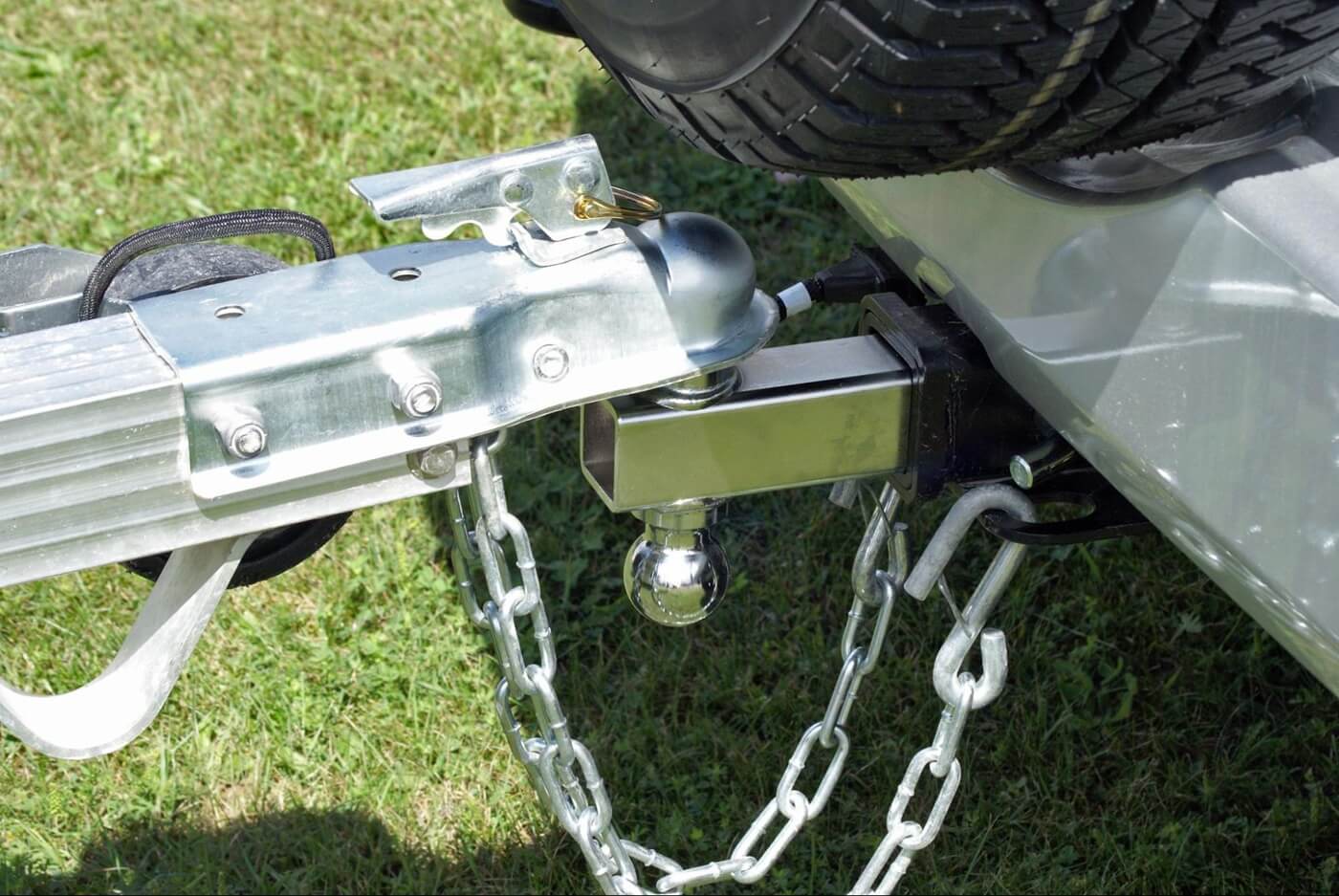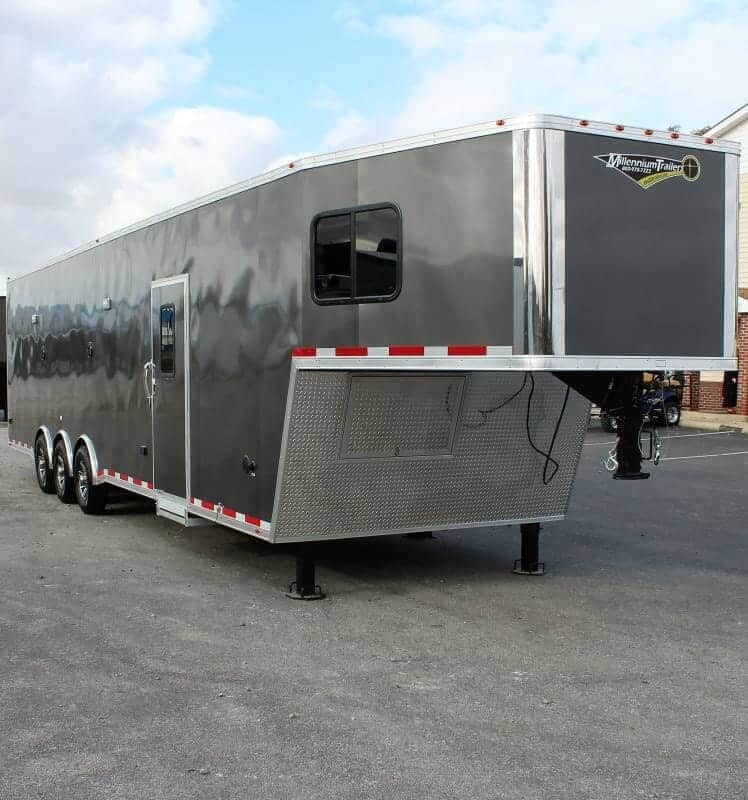

When selecting a trailer, one of the most crucial decisions you’ll face is whether to go with a gooseneck or a bumper pull trailer. Each has distinct advantages and disadvantages, and your choice will significantly impact your towing experience, cargo capacity, and overall convenience. In this article, we’ll dive deep into the pros and cons of gooseneck vs. bumper pull trailers to help you make an informed decision.
Gooseneck and bumper pull trailers are the two most common types of hitches used in towing. A gooseneck trailer attaches to a ball hitch in the bed of a pickup truck, while a bumper pull trailer connects to a hitch at the rear of the vehicle. Both serve specific purposes and are favored by different types of users, from hobbyists to professional haulers.
Choosing the right type of trailer depends on various factors, including what you need to tow, your towing vehicle, and your comfort level with maneuvering larger or more complex rigs. This guide overviews the strengths and weaknesses of each option, helping you isolate the best fit for your needs.
Gooseneck trailers offer a range of benefits that make them a top choice for those needing robust towing capabilities and enhanced stability. Let’s explore the key advantages that set them apart.
One of the most significant advantages of a gooseneck trailer is its stability. The hitch, in this case, is positioned over the rear axle of the truck, which distributes weight more evenly and reduces the chance of trailer sway. This feature is particularly beneficial when hauling heavy or large loads, such as livestock, vehicles, or construction equipment.
Gooseneck trailers are designed to handle more weight than bumper pull trailers. They can tow up to 30,000 pounds, making them ideal for heavy-duty tasks. This makes them a preferred choice for professionals who regularly transport large, bulky items.
The positioning of the hitch over the rear axle allows for tighter turns and better maneuverability, especially in confined spaces. This is a significant advantage when navigating tight corners or backing into challenging spots.
Due to their design, gooseneck trailers typically offer more space for cargo. They can include living quarters or additional storage space, making them an excellent option for long trips or transporting multiple items.
The gooseneck design naturally reduces the sway that is common with bumper pull trailers. This feature ensures a smoother and safer ride, especially at significant speeds or in windy conditions.
Disadvantages of Gooseneck Trailers
While gooseneck trailers have many strengths, they also come with certain drawbacks that might influence your decision. Understanding these disadvantages is crucial before making a purchase.
A gooseneck trailer requires a pickup truck with a compatible bed, which can be a limiting factor for those who don’t already own one. This type of trailer is not compatible with SUVs, vans, or smaller vehicles, making it less versatile for casual users.
Installing a gooseneck hitch is more complex than a bumper pull hitch and typically requires professional installation. The process involves securing the hitch in the truck bed, which may involve drilling or modifications to the vehicle.
Gooseneck trailers and hitches tend to be more expensive than their bumper pull counterparts. The increased price point can be a significant investment, particularly for those who do not need the extra towing capacity or stability.
Gooseneck trailers are less common than bumper pull trailers, which can make them harder to find, especially if you’re looking for a used model. This limited availability can also mean fewer options in terms of size, features, and pricing.
Due to their larger size, gooseneck trailers can be more challenging to store when not in use. They require more space, and finding a suitable storage location can be difficult, particularly in urban areas.

Bumper pull trailers are known for their versatility and ease of use, making them a popular option for a wide range of towing needs. Here are the primary advantages of choosing a bumper pull trailer.
Bumper pull trailers, unlike some other configurations, can be towed by a plethora of vehicles, including SUVs, vans, and trucks. This versatility makes them an accessible option for many users, from weekend adventurers to small business owners.
The hitching process for a bumper pull trailer is straightforward and can usually be done without professional assistance. This ease of use makes them a popular choice for first-time trailer owners.
Bumper pull trailers are generally less expensive than gooseneck trailers, both in terms of the trailer itself and the hitch. This affordability makes them an attractive option for those on a budget.
These trailers are typically smaller and more compact than gooseneck trailers, which can make them easier to store and maneuver in tight spaces. This size advantage also makes them a good choice for those with limited storage space.
Bumper pull trailers are more common and widely available, both new and used. This availability provides more options in terms of features, sizes, and price points.
Despite their popularity, bumper pull trailers have some limitations that may not make them suitable for every situation. Let’s take a closer look at the potential downsides.
Bumper pull trailers have a lower towing capacity than gooseneck trailers, usually maxing out around 10,000 pounds. This limitation makes them less suitable for hauling heavy or bulky items.
Because the hitch is attached to the rear of the vehicle, bumper pull trailers are more prone to sway, particularly at higher speeds or in adverse weather conditions. This can make towing more challenging and requires additional safety precautions, such as sway control devices.
The weight distribution of a bumper pull trailer is not as balanced as that of a gooseneck trailer, leading to less stability on the road. This can result in a rougher ride and more significant wear and tear on the towing vehicle.
Bumper pull trailers offer less cargo space than gooseneck trailers, making them less ideal for long trips or transporting large items. Smaller sizes can also limit the number of animals or equipment you can carry.
The longer distance between the hitch and the trailer axle in a bumper pull setup can result in a wider turn radius and more difficulty maneuvering in less generous spaces. This can be a considerable disadvantage in urban areas or when backing into confined spaces.

The decision between a gooseneck and a bumper pull trailer ultimately depends on your specific needs and circumstances. Both types of trailers have their unique advantages and drawbacks, and the right choice will hinge on what you prioritize in your towing experience.
If you require maximum towing capacity, enhanced stability, and additional cargo space, a gooseneck trailer is likely the better choice, especially for demanding tasks. However, if you prioritize versatility, ease of use, and affordability, a bumper pull trailer may be more suitable for a broader range of vehicles and more casual towing needs.
If you already own a pickup truck with a compatible bed, a gooseneck trailer might be a better investment, as it leverages the truck’s towing power to the fullest. This setup allows you to take full advantage of the gooseneck’s superior towing capacity and stability.
However, if your vehicle fleet includes SUVs, vans, or smaller trucks, a bumper pull trailer offers more flexibility with towing vehicles. This versatility means you can use the trailer with a wider variety of vehicles, making it a more adaptable choice for different towing situations.
For heavy-duty hauling, a gooseneck trailer’s higher capacity and stability are advantageous, making it ideal for transporting large loads, such as construction equipment or livestock. The gooseneck’s design minimizes sway and enhances control, which is crucial when dealing with heavier cargo.
For lighter loads and occasional use, a bumper pull trailer provides ample capacity without the extra cost or complexity associated with a gooseneck. It’s a practical solution for those who don’t require the added strength of a gooseneck but still need reliable towing for everyday tasks.
If you’re working with a limited budget, the lower cost of a bumper pull trailer may be more appealing, as it allows you to achieve your towing goals without a significant financial outlay.
This makes bumper pulls accessible to a wider audience, particularly first-time trailer owners. However, if you’re willing to invest in a higher-quality trailer, the long-term benefits of a gooseneck trailer could outweigh the initial expense, offering greater durability, stability, and capacity, which might be more cost-effective over time, especially for regular, heavy-duty use.
If you frequently tow in urban areas or tight spaces, the enhanced maneuverability of a gooseneck trailer might be worth the additional complexity, as it allows for tighter turns and easier navigation in confined environments. This feature is particularly beneficial when precise control is essential, such as parking or driving in congested areas.
On the other hand, bumper pull trailers, while generally requiring a wider turning radius, are still manageable for most drivers and may be easier to handle for those less experienced with towing.
Consider your storage options before purchasing, as they can significantly impact the convenience of owning a trailer. Gooseneck trailers require more space, both in terms of length and height, which can be a challenge if you have limited storage availability. This is particularly true if you live in an area with restrictions on trailer parking.
Conversely, bumper pull trailers are generally easier to store due to their smaller size and more straightforward design, making them a better option if space is a concern or if you need to store the trailer in a standard garage or driveway.
Both gooseneck hitches and bumper pull trailers have their individual advantages and disadvantages, and the best choice depends on your specific towing needs. By carefully considering the factors we’ve mentioned above, you can make a better-informed decision that ensures a safe, stable, and efficient towing experience.
Millennium Trailers is your trusted partner for high-quality trailers at unbeatable prices. Serving all 50 states, we’ve delivered over 5,000 trailers nationwide.
Established in 1998, we’re a company dedicated to meeting your hauling needs with excellence. Whether it’s cargo trailers or custom living quarters, we provide a wide range of options to suit your requirements. Our knowledgeable and friendly team ensures a smooth buying experience with personalized assistance. Proudly offering competitive pricing, state-of-the-art designs, and easy financing options. Committed to customer satisfaction, we strive to simplify the process of finding your perfect trailer.
Choose Millennium Trailers for a reliable, customized solution that delivers quality and value for your investment.
Copyright 1998 – 2023 Millennium Trailers, Inc.